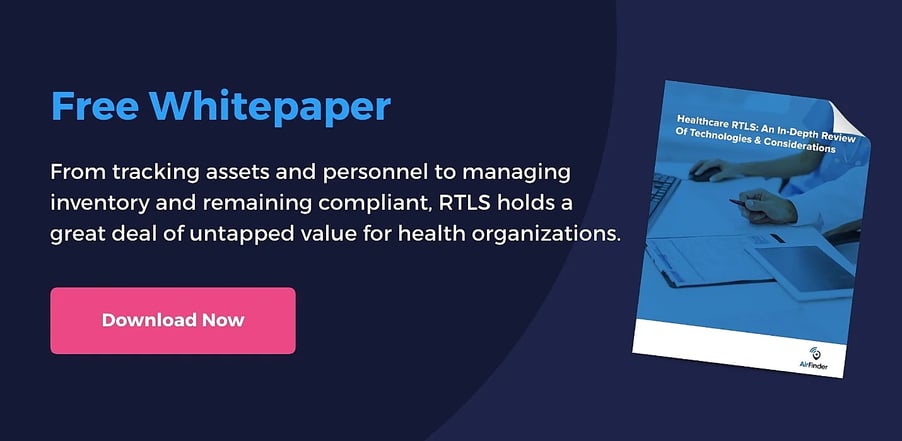While real-time location systems (RTLS) provide asset-tracking capabilities in a number of industries, healthcare may be the most developed use case. There are myriad opportunities for healthcare facilities and hospitals to increase efficiencies, cut costs, and even improve patient care through the use of tracking technologies.
There are different types of RTLS systems on the market; these include infrared, WiFi-based, ultra wide-band (UWB), and several different types of radio-frequency identification (RFID)—passive RFID, active RFID, and intelligent RFID. Below, we’ll focus on how these three types of RFID function, and the benefits and considerations to choosing a system that runs on each of them.
Passive RFID In Healthcare
How it functions:
Passive RFID uses simple, battery-free tags and high-power readers (similar to what you’ve seen in a retail store or library). The readers send out a low-frequency radio signal that transmits so much energy over the air that the tags collector antenna picks up the radio waves through brute force. The tag then transmits back to the reader using a different frequency.
Benefits:
- Passive RFID tags are extremely inexpensive (as low as 10 cents each)—a benefit if you have thousands of items to track.
- Passive RFID tags aren’t battery-powered, so they’ll last forever and never require an energy source.
Considerations:
- Passive RFID isn’t useful for determining where an item is headed—only that it has entered or left a chokepoint.
- You won’t be able to find a tagged object unless it’s placed around readers. If an object is moved or misplaced outside of where your passive RFID system is architected, you won’t be able to find it using this system.
The bottom line:
Passive RFID is a great option, if you’re looking for an inventory management system for a large number of items. For example, if you wanted to track 5,000 boxes of gauze kept in a storage room, readers placed in or around the storage room door would act as a chokepoint and register when a box is removed.
Passive RFID isn’t a great option if you want to see a tagged item moving around your hospital or healthcare center. The approach simply has too many limitations as compared to active or intelligent RFID systems. In fact, this approach has so many limitations that most healthcare providers are starting to look at alternate systems that allow them to do more.
Active RFID In Healthcare
How it functions:
Active RFID systems like AwarePoint and AeroScout are called “active” because the tags initiate connections with readers by constantly beaconing out a signal. Readers gather location data from each tagged device and send this data to the cloud. A location algorithm is then used to triangulate the position of each object being tracked.
Benefits:
- Unlike passive RFID, active RFID tells you where every tagged item is in real-time, as long as your system is architected so all tagged items are in range of a reader.
- Active RFID tags are moderately priced, usually more expensive than passive tags but lessexpensive than WiFi-based RTLS or infrared RTLS.
- Active RFID systems require less infrastructure for deployment, making them ideal for hospital or healthcare center retrofits. Infrared systems, for example, require an intense amount of infrastructure, so they aren’t ideal for installation unless you are looking at a system for new construction.
Considerations:
- Active RFID tags use batteries, which requires maintenance and upkeep. But if your system is configured appropriately, the tags can last for several years, so this isn’t a huge concern for most healthcare use cases.
- There is a ton of data flowing from active RFID readers to the cloud, which can be problematic for bandwidth or cost-constrained (from a data perspective) implementations. Depending on the number of tagged items, the number of readers, and the beacon rate of the tags, the data stream could become large enough that a cellular implementation becomes uneconomic. In fact, this is why AirFinder moved away from an active RFID system to what we like to call intelligent RFID—more on that below.
The bottom line:
Active RFID systems aren’t a bad choice if you need a low-cost tracking technology. But intelligent RFID systems can decrease power consumption (on some tagged items) and increase your location accuracy—so we believe it’s a better choice. Let’s talk through that now.
Intelligent RFID In Healthcare
How it functions:
Intelligent RFID functions similarly to active RFID in that battery-powered sensors send data to various access points, which in turn send data to the cloud. But there are marked differences between the two technologies:
Namely, in active RFID, all raw location data is sent to the cloud and an algorithm in the cloud runs those readings. But in intelligent RFID, each tag runs the location algorithm locally and then transmits location data to the cloud.
Here’s how it works: A tag is set to “wake up” at certain intervals and scan its environment for reference and access points. It then ‘knows’ where it is based on that infrastructure. If the tagged item has moved since the last interval scan, it transmits its new location. If it hasn’t moved, it doesn’t transmit anything.
Benefits:
- Data is only transmitted when necessary, which saves energy and reduces data updates. In fact, if a tagged object using intelligent RFID doesn’t move over the course of a month, the amount of data sent to the cloud as compared to an active RFID system decreases by a factor of 100.
- If your use case requires detailed location accuracy, intelligent RFID systems may be able to meet your needs. For example, AirFinder can add Bluetooth beacons called reference points into the system infrastructure that helps you tell more specifically where something is located in a room.
- Intelligent RFID systems can support low-latency applications. The scan rate of tags in these applications can be set to update rapidly enough to support low-latency applications like nurse calls. These rates can also be supported using on-tag accelerometers, which still allows for lower battery usage when the tags are not in motion. In this way, intelligent RFID technology in healthcare can compete with more costly systems like infrared RTLS.
- Intelligent RFID systems can support other bluetooth applications on the same infrastructure. Having this kind of multifunctional network allows you to link, for example, temperature data as long as it’s running on the intelligent RFID profile instead of running two separate networks.
- Intelligent RFID systems are fully connected. This means all edge devices (tags, reference points, and access points) can be addressed with downlink messages (e.g. to change configuration settings), and firmware can be updated wirelessly.
Considerations:
- Intelligent RFID tags use batteries, which requires maintenance and upkeep. Just like active RFID systems, the tags in intelligent RFID systems run on batteries, and these batteries will eventually need to be replaced. AirFinder’s approach allows users to find the right form factor and battery size to match the applications and use cases.
- Other tracking technologies have certain advantages over intelligent RFID. Infrared systems, for example, are unmatched in their ability to precisely determine location in a room, and passive RFID systems cannot be matched in their tag costs.
The bottom line:
If you want to keep your costs low but improve your tracking efficiency, intelligent RFID is your best option for RFID in healthcare. You can learn more about AirFinder’s benefits by visiting this page.
Looking for more hospital tracking information? Download our guide to healthcare RTLS.
There are many options when it comes location tracking, and using RFID in hospitals and healthcare centers can be a great choice. For more details on RFID and other tracking technologies, download our guide on healthcare RTLS.



